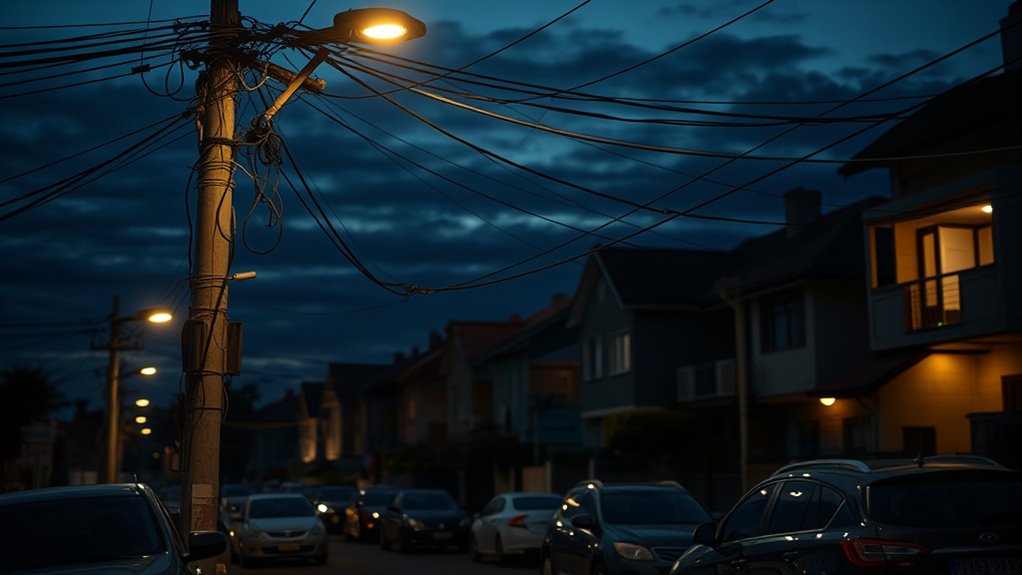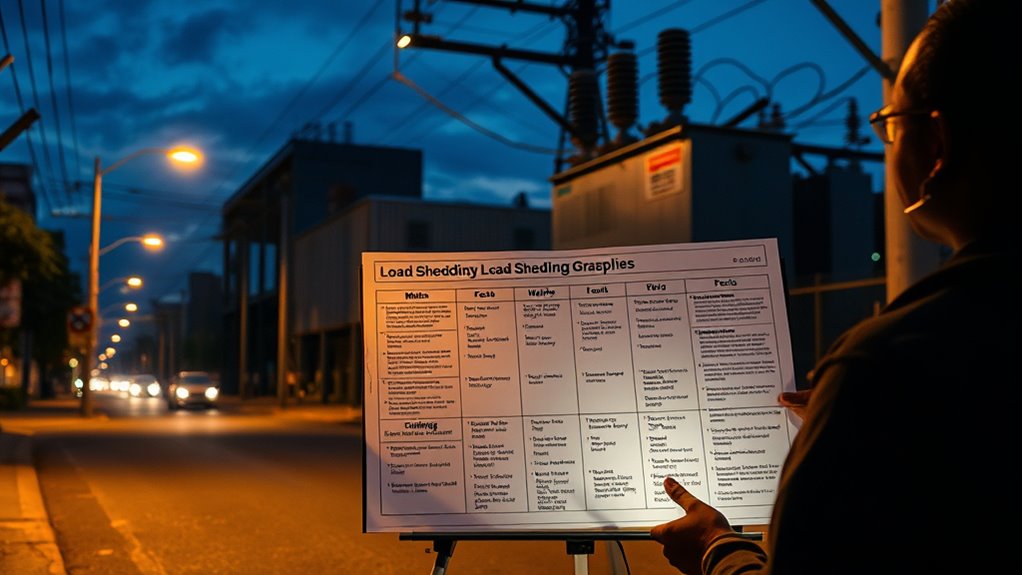Load shedding is a controlled process used by utilities to prevent blackouts when demand exceeds supply, often caused by weather, equipment faults, or growing demand. There are many myths, like backup systems always working, but in reality, outages can be due to multiple factors. Proper planning, backup solutions, and energy efficiency can help you manage these interruptions. To understand what really matters and how to stay prepared, keep exploring the details below.
Key Takeaways
- Load shedding is a controlled process to prevent grid failures during demand-supply imbalance.
- Myths include misconceptions about backup systems and the sole causes of outages.
- Proper maintenance of backup batteries ensures alarm systems remain operational during outages.
- Combining renewable sources with batteries can enhance energy resilience but has limitations.
- Effective load management and infrastructure upgrades are crucial for minimizing disruptions and ensuring stability.
Understanding the Real Causes of Load Shedding

Understanding the real causes of load shedding requires recognizing that it happens primarily when electricity demand nears or surpasses the supply available. When this imbalance occurs, the grid becomes unstable, risking widespread blackouts. To prevent this, utilities temporarily interrupt power to parts of the network, helping to balance supply and demand. Sudden spikes in demand—caused by extreme weather, like heatwaves or cold snaps—force the system to work harder. Unexpected outages at power plants or damage to transmission equipment also reduce available capacity. Rapid urbanization and population growth outpace infrastructure, adding pressure. Fuel shortages and unavailability of purchased power further diminish supply. These factors, combined with automatic protective measures, trigger load shedding to maintain grid stability and avoid catastrophic failure. Load shedding is a last resort to protect the overall integrity of the power system when other measures cannot stabilize the grid. Additionally, grid management strategies are implemented to respond swiftly and prevent system collapse during periods of stress.
Debunking Common Myths About Load Shedding

Many myths about load shedding persist, leading to misunderstandings about how and why power outages happen. It’s important to clear these up so you’re better prepared.
- Alarm systems generally aren’t disabled during load shedding because they rely on backup batteries, which can last 6-8 hours if maintained properly. So, your alarms stay active unless batteries fail or are depleted. Proper maintenance of alarm batteries ensures system activity during outages. Additionally, understanding power backup options can help you better prepare for extended outages.
- Renewable energy isn’t a magic fix; while wind and solar are cheap to operate, the total system costs and intermittency require backup sources. It’s the combination of renewables and dispatchable power that prevents load shedding.
- Load shedding isn’t only caused by generation shortages. It can also result from equipment faults, transmission issues, or weather events, all aimed at protecting the grid from failure.
Key Strategies to Manage and Mitigate Load Shedding

To effectively manage and mitigate load shedding, you should implement a combination of strategic backup power systems, load management techniques, energy efficiency measures, and smart planning. Investing in UPS systems or battery energy storage can provide immediate backup and store excess energy for outages. Pairing solar power with batteries offers sustainable, off-grid solutions that reduce reliance on the grid. Practical options like gas stoves or solar cookers help maintain essential functions during outages. Active load management, such as demand response programs and automated scheduling, shifts consumption to off-peak times, easing grid stress. Upgrading to energy-efficient LEDs, optimizing HVAC, and incorporating smart appliances cut overall demand. Using load shedding schedules for planning and automation helps minimize disruptions, ensuring safety and productivity during outages. Understanding load shedding is crucial for developing effective strategies to maintain business continuity. Additionally, selecting appropriate energy storage solutions can further enhance your resilience against power interruptions.
Frequently Asked Questions
How Long Does Load Shedding Typically Last in Different Regions?
In South Africa, load shedding usually lasts 2 to 4 hours per outage, happening multiple times over several days. In India, outages range from 2 to 6 hours daily, especially during peak seasons. Pakistan experiences 4 to 6 hours of daily outages, while Lebanon and Sri Lanka often face 1 to 2 hours of power daily. Developed countries have shorter outages, typically under an hour, during emergencies.
What Are the Economic Impacts of Frequent Load Shedding on Businesses?
Imagine your business walking a tightrope daily—frequent load shedding causes instability, making growth harder. You face rising costs from backup power and lost productivity, leading to lower income and customer trust. Operations slow down, supply chains stretch thin, and stress mounts. This ongoing challenge stifles your ability to innovate or expand, ultimately hampering your business’s resilience and vision for the future amidst unpredictable power disruptions.
How Can Consumers Prepare for Scheduled or Unexpected Outages?
You can prepare for outages by stocking up on non-perishable foods and keeping hot water in flasks for heating. Charge all your devices beforehand and keep emergency lights and batteries handy. Monitor official schedules through social media or websites, and inform your family about the plan. Use alternative cooking methods like gas stoves or solar cookers, and unplug unnecessary electronics to save energy during outages.
What Technologies Are Used to Detect and Respond to Load Shedding Triggers?
You rely on AI and machine learning technologies to detect and respond to load shedding triggers. These systems analyze data like energy consumption, weather, and user behavior to predict demand spikes. They use digital twins for real-time disturbance assessment and centralized controllers for proactive load management. Protection relays quickly detect issues, triggering automated load shedding within milliseconds, ensuring grid stability and preventing outages effectively.
How Does Load Shedding Affect Critical Infrastructure Like Hospitals and Emergency Services?
Imagine a hospital as an essential heartbeat, and load shedding as a sudden pause in its rhythm. When power cuts happen, you might see EMS use spike over 50%, with longer on-scene times delaying care. Smaller facilities often transfer patients, straining emergency services and increasing hospital congestion. Critical devices like ventilators shut down, risking patient safety. It’s a ripple effect that hampers communication, delays treatment, and impacts both staff and patients profoundly.
Conclusion
Understanding the true causes of load shedding and busting myths helps you stay prepared. Did you know that over 80% of outages are due to maintenance issues rather than shortages? By staying informed and adopting key strategies, you can better manage disruptions. Remember, knowledge is your best tool to navigate load shedding effectively. Stay proactive, and you’ll minimize its impact on your daily life.










